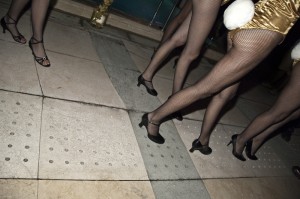Oct 19, 2010 0
Consider the Bunny
There was no such person as Marilyn Monroe. Marilyn Monroe was an invention of hers. A genius invention that she created, like an author creates a character,” Richard Avedon
In the most famous portrait of Marilyn Monroe, she stares downwards and to her left; her mouth slightly open. Her shoulders slump, and a few errant blonde strands of hair stick out against the dark grey background. In contrast to her famous white dress blowing up, her dark sequined dress weighs her down as she takes an exhausted moment to collect herself. For that moment, she’s not the Marilyn Monroe of her own invention; she’s Norma Jean, the lonely woman whose mother was institutionalized and whose father was never there. Both the tragedy of her life and the strain and brilliance of her creation can be read into the Richard Avedon shot. She’s no longer just a pin-up; she’s fully human with all the accompanying the emotions and messy story-lines.
It was with this photo in mind that I decided to attend and photograph Macau’s Playboy Bunny Hunt. There would be 15 women trying out to be a bunny for the new Playboy Club in Macau. I assumed I wouldn’t need the genius of Avedon to capture the accidental candor of young women in the draining task of embodying a character that exists to excite men. I pictured a number of local girls eagerly and sometimes awkwardly trying to please everyone as they struggled to be a Playboy Bunny, an invention every bit as a much as Marilyn Monroe. Though Playboy’s characters are a bit—and I never thought I’d use this adjective to describe them—flat, without the decades of Playboy’s presence in the cultural milieu, it would’ve been very difficult for a local Chinese girl to perform the Bunny role.
When I arrived at the Sands Casino, however, the potential bunnies were hid away for most of the night while Playboy had shipped in Bunnies from their Las Vegas club. Dressed up in the once iconic ears, fluffy tail and fishnet stockings, these Bunnies were true professionals. It’s a classic photo trick to take a smiling—often boring—photo of a group, and then wait a beat or two for people to relax and take another shot when they’re not expecting it. But these Bunnies never let down their guard. Often looking back at an event, you realize that you missed the moment that would’ve made that killer shot. Not this time. These were objectively gorgeous women, but I didn’t get a single interesting shot of their faces since I didn’t once see them out of character. The Bunnies were machine-like in their charm.
How did Avedon capture the Marilyn moment? After all, she was the ultimate pro at continuously living out her character. There’s one—almost definitely apocryphal—story that he had one of his assistants burst into the studio and say he had just runover a puppy. The moment she heard the sad news, Avedon snapped the photo.

